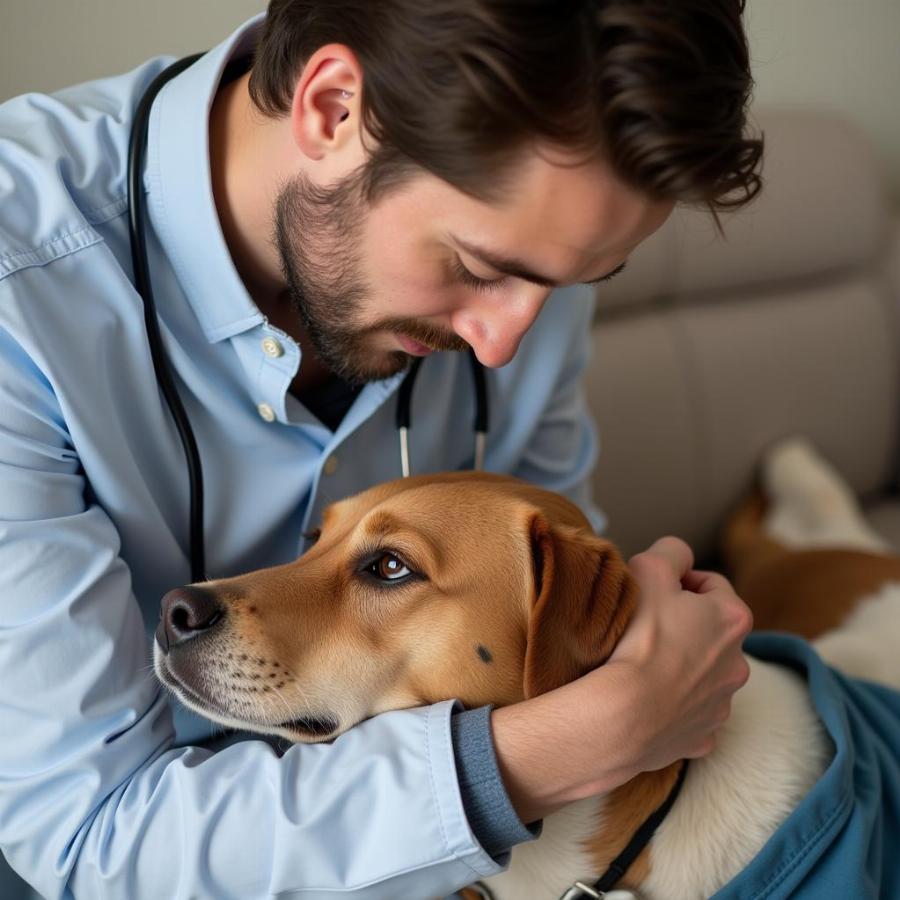Anal gland carcinoma in dogs is a relatively uncommon but serious type of cancer affecting the anal sacs. These small glands, located on either side of the anus, produce a foul-smelling fluid that dogs typically express during defecation. While not every lump near a dog’s anus is cancerous, anal gland carcinoma can be aggressive and requires prompt diagnosis and treatment. Understanding the symptoms, diagnosis, and treatment options can empower owners to act quickly and provide the best possible care for their beloved companions.
Understanding Anal Gland Carcinoma in Dogs
Anal gland carcinoma, also known as apocrine gland anal sac adenocarcinoma (AGASACA), typically affects older dogs, with a median age of diagnosis around 10 years old. Certain breeds, such as Cocker Spaniels, German Shepherds, and Beagles, may be predisposed. While the exact cause of anal gland carcinoma isn’t fully understood, hormonal factors are suspected to play a role.
Symptoms of Anal Gland Carcinoma
Recognizing the early signs of anal gland carcinoma is crucial. These can include:
- Straining or difficulty defecating: This can often be mistaken for constipation.
- Scooting or licking the anal area excessively: While this can also indicate impacted anal glands, persistent licking or scooting warrants veterinary attention.
- Visible swelling or lumps near the anus: These lumps may be firm or soft and can vary in size.
- Blood or pus in the stool: This can be a sign of more advanced disease.
- Weight loss, lethargy, and decreased appetite: These general symptoms may indicate the cancer has spread.
If your dog exhibits any of these symptoms, it’s essential to consult a veterinarian immediately. dogs with hemorrhoids may also exhibit some similar symptoms, making a proper diagnosis crucial.
Diagnosing Anal Gland Carcinoma
Diagnosing anal gland carcinoma involves a thorough physical exam, including palpation of the anal glands. Your veterinarian may recommend further tests such as:
- Fine-needle aspiration (FNA): This procedure involves collecting cells from the affected area for microscopic examination.
- Biopsy: A tissue sample is taken for a more definitive diagnosis.
- Imaging tests (X-rays, ultrasound, CT scan): These help determine the extent of the tumor and whether it has spread to other parts of the body, particularly the regional lymph nodes.
Treatment Options for Anal Gland Carcinoma
Treatment for anal gland carcinoma depends on the stage of the cancer and may involve:
- Surgical removal of the tumor: This is often the primary treatment option, especially if the cancer is localized.
- Radiation therapy: This may be used in conjunction with surgery or as the primary treatment if surgery isn’t feasible. perianal mass dog can also require similar treatment protocols, emphasizing the importance of accurate diagnosis.
- Chemotherapy: This may be used to slow the progression of the cancer, particularly if it has spread.
What is the prognosis for dogs with anal gland carcinoma?
The prognosis for dogs with anal gland carcinoma varies depending on the stage at diagnosis and the extent of the tumor’s spread. Early detection and aggressive treatment are crucial for improving the chances of survival.
Living with a Dog Diagnosed with Anal Gland Carcinoma
Caring for a dog with anal gland carcinoma involves managing pain, providing nutritional support, and ensuring regular veterinary checkups.  Caring for a Dog with Anal Gland Carcinoma Your veterinarian can recommend pain medications and dietary adjustments to help maintain your dog’s comfort and quality of life. dog anal tumor can be challenging for both the dog and the owner, requiring dedication and consistent care.
Caring for a Dog with Anal Gland Carcinoma Your veterinarian can recommend pain medications and dietary adjustments to help maintain your dog’s comfort and quality of life. dog anal tumor can be challenging for both the dog and the owner, requiring dedication and consistent care.
Conclusion
Anal gland carcinoma in dogs is a serious condition requiring prompt attention. By being aware of the symptoms and seeking veterinary care at the first sign of a problem, owners can give their beloved companions the best chance at a positive outcome. Early diagnosis and appropriate treatment are crucial for managing this challenging disease. anal cancer in dogs is a topic that demands ongoing research to improve treatment options and enhance outcomes for our furry friends. round cell carcinoma in dogs is another type of cancer that can affect dogs and requires specialized veterinary care.
FAQ
- What is the most common symptom of anal gland carcinoma? Straining during defecation is often the first noticeable sign.
- Is anal gland carcinoma always fatal? No, but early detection and treatment are crucial for a positive prognosis.
- How is anal gland carcinoma diagnosed? Diagnosis typically involves physical exam, FNA, biopsy, and imaging tests.
- What are the treatment options for anal gland carcinoma? Surgery, radiation therapy, and chemotherapy are common treatment options.
- How can I make my dog comfortable after anal gland carcinoma surgery? Pain medication and a soft diet can help during recovery.
Beaut Dogs is your trusted source for comprehensive information on dog breeds, health, and care. We are dedicated to providing valuable resources to help you navigate the joys and challenges of dog ownership. When you need expert advice, please contact us at Email: [email protected] so Beaut Dogs can give detailed and accurate answers. Visit us at https://beautdogs.com.